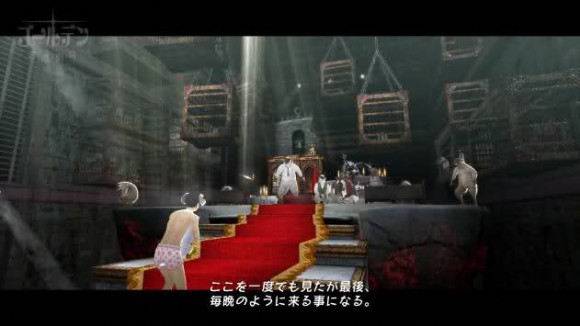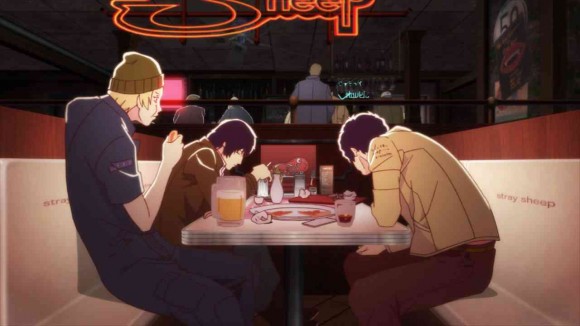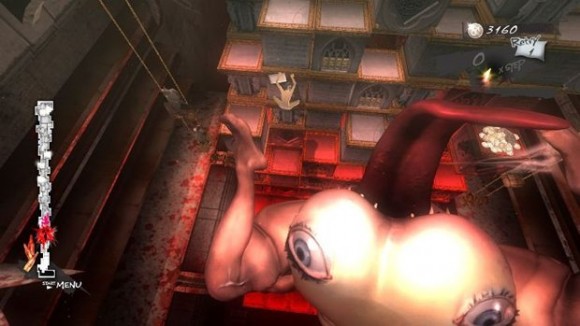Review: Catherine (Xbox 360)
/ For a gamer seeking a challenge, there’s nothing quite as satisfying as playing a game that’s easy to learn, difficult to master and eventually completely wipes the floor with you. Atlus’ Catherine is such a game; it is in a class all its own, a hybrid puzzle-platformer with fast-paced, quick-thinking strategic gameplay. The game also benefits greatly from a complex and engaging storyline that’s influenced by the player’s decisions. I haven’t played anything like Catherine and despite puzzle games not being my favorite genre it’s made me something of a convert.
For a gamer seeking a challenge, there’s nothing quite as satisfying as playing a game that’s easy to learn, difficult to master and eventually completely wipes the floor with you. Atlus’ Catherine is such a game; it is in a class all its own, a hybrid puzzle-platformer with fast-paced, quick-thinking strategic gameplay. The game also benefits greatly from a complex and engaging storyline that’s influenced by the player’s decisions. I haven’t played anything like Catherine and despite puzzle games not being my favorite genre it’s made me something of a convert.
The game’s prevalent morality system is subtle and less intrusive than most games, and eight endings and three difficulty levels, on top of the fantastic unlockable modes – the challenging, randomized ‘Babel’ mode, which supports co-op play and the ‘Colosseum’ mode where you can face off against your friends, offer immense replay value for those who enjoy the game’s frantic gameplay.
Law VS Chaos
Our protagonist Vincent is in quite a pickle. He’s been having disturbing dreams that he can’t remember upon waking, and on top of that his doting but concerned girlfriend Katherine wants to take their relationship to the next level, something the irresponsible early-thirties bachelor isn’t quite prepared for.

To make things even worse, a streak of gory deaths around the town has left many men dead in their sleep, their faces horribly contorted. Terrible rumors start to circulate about nightmares or curses being the cause of the deaths. The speculation and wild theories regarding its origins escalate as more men die each day.
But the biggest upset comes in the form of a spritely younger woman ironically named Catherine, who Vincent discovers in bed with him one surprised morning. She’s immediately possessive of him and her unusual behavior catches Vincent off-guard, which stalls him from taking immediate action. The choice is yours whether to work to establish order in Vincent’s life and take a stand with dutiful Katherine, or give into Vincent’s sexual impulses and continue his relationship with the voluptuous Catherine. The player’s story choices reflect strongly in Catherine’s flexible storyline resulting in different sets of cut-scenes and ultimately, one of eight very different endings.
Vincent is given many options and ways to choose between Katherine and Catherine: there are text messages to respond to, on-the-fly decisions to be made and, at the end of every level, questions asked by a mysterious NPC character that influence the Karma meter, which determines Vincent’s eventual outcome. What’s great about the morality system is that it’ not always clear what the ‘right’ choice is, nor is it necessary to play a ‘perfect’ game in order to get every ending. On subsequent playthroughs, the player has the option to skip any levels they received Gold trophies on, which makes seeing every ending much quicker and easier.
A seemingly endless tower…
For most of your time playing Catherine, you’ll be climbing your way up a giant tower, which is divided into nine different floors, often composed of multiple levels. Each level consists of giant stacks of blocks, which are crumbling one row at a time from the bottom-up, so the idea is to quickly scale the stacks to make it to the top without trapping yourself and making it impossible to progress.
It’s not as simple as building a Lego set. You can push and pull the blocks in order to make stairways, and they snap together as long as two edges are touching, so there are a lot of possibilities for linking them together to create steps and bridges. You can also climb around blocks by hanging off the edges, but caution must be made in terms of pushing blocks off the edge – push the wrong block off or box yourself into a position where you’re trapped, and you can easily find yourself stranded and have to undo a move, or several.
The undo function is what keeps this game from being impossibly difficult, but the kicker is that the undo function is limited. In Normal mode you have up to 9 undos, and often even nine moves is not enough if your strategy turns sour on you. There are over a dozen types of blocks, but many of them you’ll encounter only sparsely. Most are harmful or force you to work within certain limitations, such as the trap blocks (which send out spikes to kill you), dark blocks (which are heavy and take a long time to move) and cracked blocks (which don’t last very long). The most useful block type will launch you up about five blocks upwards, but you don’t see those very often.

You can pick up various items on the levels to help you out, such as an item that fries any opponents, or one that gives you a free block. Often they can be out of your way, but a good item is almost always worth it since they help you survive and shave time off your totals allowing you to make better time and unlock trophies and songs. Items can also be purchased on the landings when Vincent is conversing with the other sheep. Coins, the game’s currency that also function as score multipliers, appear all over the puzzles but often take a little extra effort to acquire, something that becomes easier as you try, fail and get more used to the puzzle over time.
Occasionally there are sheep that will get in your way and knock you off, or climb on top of your blocks and mess up your arrangement. Vincent can shove these guys aside with his pillow, or as I prefer to do, box them off with a wall. In many cases these encounters can be lethal, but sometimes a sheep can actually be helpful by activating spike blocks for you.
This all takes place faster than you would expect from a puzzle game, and due to its challenging nature I found Catherine to be several levels more frantic than most modern action games. You have to use your noggin quite a bit, so it’s very possible to reach a point where you need to simply pause and take a break in order to give your internal RAM a rest. If you just go through this game mindlessly without planning your next move, you’ll be dead in no time. Quick assessment of each situation is downright necessary for survival. Once the difficulty really ramps up you have to be as efficient as possible with your moves lest you fall off the stage or succumb to the various horrors that pervade Vincent’s restless nights.
Various simple and complex techniques will help you stay alive so you can make it to the top, and during the landings between levels Vincent can discuss increasingly complicated and diverse strategies with other sheep stuck making the endless climb.
As for the game’s infamous difficulty, after the third night or so you’ll begin to see what creative means of torture the developers are capable of inflicting.
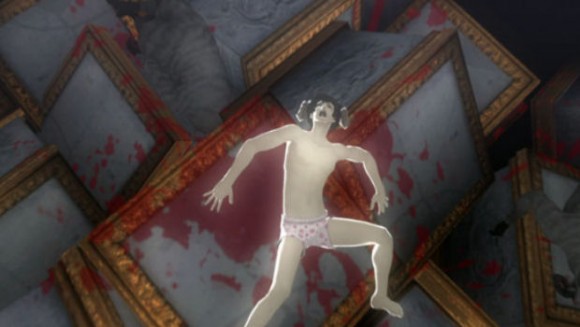
You will die in this game. A lot.
Thankfully the retries (pillows) are pretty easy to rack up and there are checkpoints so it’s not easy to get a Game Over, but it can be frustrating. Sometimes you’ll wish there was no time limit, or no enemies, but it’s not long before you’ll develop the ability to think quickly and instinctively under pressure, and for those who simply want to experience the game’s in-depth story, watching videos on YouTube can be very helpful, and playing the game on Easy is always an option.
I didn’t get to try Easy but instead powered through the Normal mode, although I was tempted at times to just bite the bullet and start from scratch. Normal offers a hearty challenge, but Hard is quite unforgiving. I’d recommend Hard for masochists and Normal for everyone else. I find it quite remarkable that in Region 1 territories the game’s difficulty was actually diluted from the Japanese version due to complaints from players - shortly after release, the Japanese version was patched because some players couldn’t even beat the game on Easy mode. That should tell you a little something Catherine. The upside is that every time you best a level, you feel a really great sense of accomplishment.
Boss battles consist of challenging levels wherein Vincent must also avoid periodic attacks, which vary in terms of their effects, intensity and timing. Certain bosses may send down an odd potion that reverses your controls, trap you or kill you instantly. Bosses are also quick climbers so Vincent has to be even faster than usual. I developed the habit of drinking all three drinks each night at the bar before the puzzles in order to boost Vincent’s speed during that evening's nightmares.
The stray sheep…
The bulk of the gameplay takes place in Vincent’s nightmares, when he and countless other ‘lost lambs’ are led into an odd vertical labyrinth of seemingly endless boxes, but every night you also control Vincent at the Stray Sheep, the dive bar which could be straight out of a Haruki Murakami book where Vincent and his friends routinely kick back for some beer and pizza.
At the Stray Sheep, players can converse with other patrons, replay past levels to challenge your own scores and unlock trophies, receive and reply to text messages from Katherine and Catherine, chug some beer (which increases Vincent’s speed during that night’s puzzles), enjoy a host of unlockable songs on the jukebox (there are even tracks from the Persona and Shin Megami Tensei series), and play ‘Rapunzel’, an arcade game with the same block-pushing mechanics as the main puzzles but with a limited number of moves rather than a time limit. I was always on the lookout for situations that involve player choices, since they will often affect the Karma meter.
Time passes at the bar and people come and go. Talking to them reveals interesting story elements and Vincent even encounters people who may or may not be the various sheep he’s encountering in his dreams. If you’re looking for interesting characters, look no further than Catherine. By the end of the game it’s hard not to be invested in Vincent’s life and those of his female companion/s and friends. Even the most throwaway side characters in this game have their own stories, and most of them tie into the main theme of relationships and seemingly universal problems inherent in male-female relationships. It’s all great stuff and very appropriate for a game that deals with the always rich subject of infidelity.
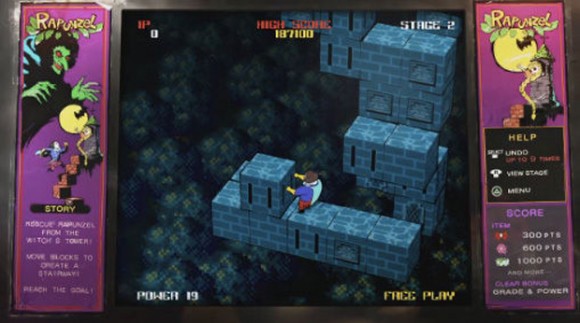
At the enticing arcade machine in the corner, you have three credits per night to spend on ‘Rapunzel’, which quickly becomes quite challenging and has over sixty full levels, which is just insane considering that it’s merely a mini-game. There are no enemies, but a limited number of moves with which you can push/pull blocks. ‘Rapunzel’ is for the players that want a more focused, less stressful cerebral experience. It’s actually harder than the main game towards the end. The only complaints I have about ‘Rapunzel’ are that your progress each night is limited, and the terrible music sticks out like a sore thumb from the rest of the game’s amazing soundtrack. I found myself stuck early on and decided to forego this diversion, but for other players I’m sure it will end up being a massive timesink.
For a game where you mostly push, pull and navigate around blocks, the wealth of extras and the attention to detail paid to every awkward moment of Vincent’s life is surprising but very welcome, especially considering the game’s length of about 20 hours, not including Babel mode.
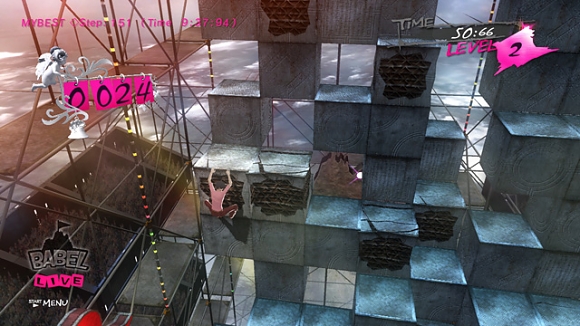
Extra challenges! Babel and Colosseum mode
By achieving Gold trophies in the main game, players can unlock various levels in Babel mode, where you undergo lengthy, randomized puzzle gauntlets that will test every technique you learned in the main game and push you to the limit in terms of making up strategies on the spot and figuring your way out of desperate situations. The goal in each of the Babel levels, as always, is to reach the end, and even though it often seems like there’s no end in sight the game does tell you how many flights you’ve climbed up, which can be inspiring if you know you’re nearing the end. Even the first tower, Altar, contains a whopping 150 steps, which is a lot more difficult than it probably sounds. The last Babel scenario, Axis Mundi (unlockable by getting 9 Gold trophies), is 300 steps long and contains the deadly vortex blocks, which can topple the entire tower with one misstep and put an end to all your hard work.
Babel can also be played in co-op mode, which I imagine can be fun in theory but absolutely must be played by someone who knows the game, since you can easily get in each others’ way and both players need to make it to the top at the end.
The Colosseum is another welcome addition to Catherine - it’s as good as you could imagine a head-to-head multiplayer experience in this game could be. You go head-to-head with a buddy, and knock him/her off the stage. You get two chances, so if your opponent falls off twice, you win. The other way to win is to get to the top before they do. This can get quite insane, and there’s actually a few levels of strategy involved in one-upping your friends - if you get too caught-up in fighting and the stage begins to collapse from underneath you, just making sure you’re above your opponent will ensure that they fall to their doom, which can result in some pretty heated matches. Of course, Catherine is primarily a single-player game but Colosseum is a fun little diversion. Hopefully it doesn’t ruin too many friendships.
Fantastic Audio and Visuals
Quite surprisingly, Catherine’s soundtrack is top-notch and especially appealing to lovers of classical music. Such classic pieces as Dvorak’s “The New World”, Beethoven’s “Symphony No. 5”, Rossini’s “William Tell Overture” and two pieces by Chopin are given the modern treatment with fantastic remixes that offer a diverse soundtrack that’s refined and fun, jazzy and atmospheric. Having pre-ordered the game, I got a free ‘sound disc’ and art book, and both were very worth it.
The other thing that surprised me was that the English dub is actually pretty decent. When I started seeing the first previews for this game I was frustrated to learn there was no way to play with the original Japanese voice cast, since I prefer reading subtitles to a half-hearted dub, but I was actually pleasantly surprised that the dub works perfectly and everyone is well-cast, especially the bubbly but seductive titular Catherine.
As for its visual style, the game does not disappoint. The art looks to be taken straight from an anime, and the character designs show it. Each of the characters has a distinct style. The game’s fantastic use of color and well-placed intricate details also means that each location is distinct and atmospheric.
The grotesque bosses are truly accomplishments in art direction. I wouldn’t mind having collectible figures of some of them.
The many cut-scenes are very well done; even though most of them take place in the same five or six locations, the camera angles, editing and lighting are top-notch. The only issue I had with them was that the Xbox 360 version’s load times are annoying and interrupt the flow of the narrative in between the various cinematic segments.
While most of the cut-scenes use the game’s cel-shaded graphics, during some crucial moments the game morphs into an awesome anime style that made me yearn for someone to adapt this game into an OVA (animated mini-series). There’s serious potential here; there’s already a great soundtrack, characters, and even a voice cast.
Each step of Vincent’s tale is cinematically illustrated in a way that’s engrossing and rewarding, especially if you are as interested in the ways games handle ethical questions, such whether it is possible for a cheater to find redemption and what kinds of responsibilities Vincent has, both towards Katherine and himself. It makes you wonder why western developers often hire writers halfway through the development process, when a good story can be such a great motivator to inspire people to finish a game even when it’s so difficult it ends up feeling hopeless or frustrating.
Overall
Catherine is a rare gift, a diamond in the rough in this genre-arrested, sequel-driven industry: a brand-new property, a hardcore puzzle game from Atlus’ legendary Persona team that boasts fantastic production qualities, a deep, engaging storyline with memorable characters and a surprising amount of replay value. It’s the kind of game that accomplishes absolutely everything it set out to do, and offers more than you asked for with additional modes, multiple endings and cut-scenes and a slick, refined presentation that really sells the whole experience.
It’s not a game for everyone, but for any serious gamer looking for something new and challenging or for anyone who loves puzzle games, Catherine hits the spot perfectly. My favorite games are all about crunchy, satisfying and difficult gameplay that really puts the player’s creativity and strategies to the test. Catherine is one of the best releases this year, and even though a slew of tripe-A titles are just around the corner, I don’t think my opinion of this game’s classic status is going to change. For the time and attention paid to the story and atmosphere alone, Catherine is currently one of my favorite games of this generation.
Score: 95/100
Pros
- Great story and fast-paced hybrid puzzle/platformer gameplay
- A wide variety of options and challenges
- Fantastic soundtrack and art
Cons
- May be too difficult for some
- No option for original Japanese voice cast
- Xbox 360 version has annoying loading times in story mode

